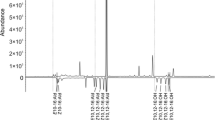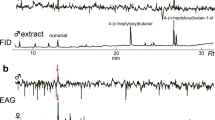Abstract
GC profiles of the airborne volatiles produced by adult males and females of the rice bug,L. chinensis showed no qualitative chemical dimorphism. However, GC-EAD experiments showed that eight of the compounds elicited strong responses in male and female antennae. Ruling out alarm pheromone and compounds that were not found in the whole-body extracts of the bugs, four compounds remained to be tested as possible attractants. In field experiments, the whole mixture or tertiary blends were not attractive: however, males were strongly attracted to a 5 : 1 mixture of 2-(E)-octenyl acetate and octanol. The attractancy of the binary mixture was decreased by the addition of 3-(Z)-octenyl actetate. Although the binary lure specifically attracted males, there was no evidence that it triggered any response of sexual behavior in males.
Similar content being viewed by others
References
Anonymous, 1989. Software for statistical visualization on the Apple Macintosh. JMP introductory guide. SAS Institute, Inc., Cary, North Carolina.
Aldrich, J. R. 1995. Chemical communication in the true bugs and parasitoid exploitation, pp. 318–363,in R. T. Cardé and W. J. Bell (eds.). Chemical Ecology of Insects II. Chapman & Hall, New York.
Aldrich, J. R., Waite, G. K., Moore, C., Payne, J. A., Lusby, W. R. andKochansky, J. P. (1993). Male-specific volatiles from Neartic and Australasian true bugs (Heteroptera: Coreidae and Alydidae).J. Chem. Ecol. 19:2767–2781.
Baker, T. C. 1989. Sex pheromone communication in the Lepidoptera: New research progress.Experimentia 45:248–262.
Blum, M. S. 1985. Alarm pheromones, pp. 193–224,in G. A. Kerkut and L. I. Gilbert (eds.). Comprehensive Insect Physiology, Biochemistry and Pharmacology, Vol. 9, Pergamon Press, Oxford.
Gunawardena, N. E., andBandumathie, M. K. 1993. Defensive secretion of the rice bug,Leptocorisa oratorius Fabricius, (Hemiptera: Coreidae): A unique chemical combination and its toxic, repellent, and alarm properties.J. Chem. Ecol. 19:851–861.
Leal, W. S., andKadosawa, T. 1992. (E)-2-Hexenyl hexanoate, the alarm pheromone of the bean bugRiptortus clavatus (Heteroptera: Alydidae).Biosci. Biotech. Biochem. 56:1004–1005.
Leal, W. S., Mochizuki, F., Wakamura, S., andYasuda, T. 1992. Electroantennographic detection ofAnomala cuprea Hope (Coleoptera: Scarabaeidae) sex pheromone.Appl. Entomol. Zool. 27:289–291.
Leal, W. S., Higuchi, H., Mizutani, N., Nakamori, H., Kadosawa, T., andOno, M. 1995. Multifunctional communication inRiptortus clavatus (Heteroptera: Alydidae): Conspecific nymphs and egg parasitoidOoencyrtus nezarae use the same adult attractant as chemical cue.J. Chem. Ecol. 21:973–985.
Nordlung, D. A. 1981. Semiochemicals: A review of the terminology, pp. 13–28,in D. A. Nordlund, R. L. Jones, and W. J. Lewis (eds.). Semiochemicals: Their Role in Pest Control, Wiley & Sons, New York.
Nordlund, D. A., andLewis, W. J. 1976. Terminology of chemical releasing stimuli in intraspecific and interspecific interactions.J. Chem. Ecol. 2:211–220.
Struble, D. L., andArn, H. 1984. Combined gas chromatography and electroantennographic recording in insect olfactory responses, pp. 161–178,in H. E. Hummel and T. A. Miller (eds.). Techniques in Pheromone Research. Springer-Verlag, Tokyo.
Tamaki, Y. 1985. Sex pheromones, pp. 145–191,in G. A. Kerkut and L. I. Gilbert (eds.). Comprehensive Insect Physiology, Biochemistry and Pharmacology, Vol. 9, Pergamon Press, Oxford.
Author information
Authors and Affiliations
Rights and permissions
About this article
Cite this article
Leal, W.S., Ueda, Y. & Ono, M. Attractant pheromone for male rice bug,Leptocorisa chinensis: Semiochemicals produced by both male and female. J Chem Ecol 22, 1429–1437 (1996). https://doi.org/10.1007/BF02027722
Received:
Accepted:
Issue Date:
DOI: https://doi.org/10.1007/BF02027722




